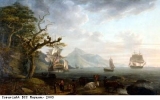John Pinney: a plantation owner
John Pinney was born in 1740 and died in 1818. He was a rich sugar plantation owner and slave owner from Bristol. In 1762 he inherited, from his cousin John Frederick Pinney, MP for Bridport in Dorset, land in the West Country and several slave plantations on the small island of Nevis in the Caribbean. John Pinney commissioned a painting of the island, which hangs in the Drawing Room of what was his Bristol home at 7, Great George Street. It is now known as the ‘Georgian House’ and is open to the public as a museum. The painting pictured here is a romanticised view of the west coast of the Caribbean island of Nevis seen from St. Kitts. It is by the Bristol-born painter and sea captain Nicholas Pocock, who visited the Caribbean on several occasions.
In December 1764 John Pinney went to Nevis to supervise the plantations. He found them run down and in debt. Many of the slaves were too old or too ill to work. As their owner, it was in Pinney’s best financial interest to make sure that they were no longer his responsibility. In order to do this, Pinney offered the slaves their freedom within certain limits. Pinney considered them to be free, although he could not actually free them for inheritance reasons. In doing this, Pinney probably no longer had to pay the taxes that the Nevis Assembly (the local government) charged on each slave. By treating them as freed, Pinney would also have the excuse of not having to pay for any medical treatment that a sick slave might need. Although most slaves rarely received adequate medical treatment, in theory it was the owner�s responsibility to treat those who were ill.
Pinney then bought new slaves whom he could ‘season’ to the work. ‘Seasoning’ was a period of one to three years, during which time new slaves were expected to get used to their work and the harsh treatment suffered at the hands of the plantation owner. The slaves who were being seasoned did not have to work as hard the others. Between 1765 and 1769 he bought 66 slaves, most of them were children and probably brought straight from Africa. Some seem to have been sold directly by the captain of the slave ship, others were sold by firms of slave dealers such as Smith and Baillies on the neighbouring Caribbean island of St. Kitts.
On ‘Mountravers’, Pinney’s main plantation, of 394 acres, he owned between 170 and 210 slaves. They produced on average about 110 ‘hogsheads’ (30,000kg) of sugar and around 7,250 gallons (33,000 litres) of rum a year. These products would then be shipped to agents in London and Bristol. The agents would find buyers for the sugar and rum in England.



